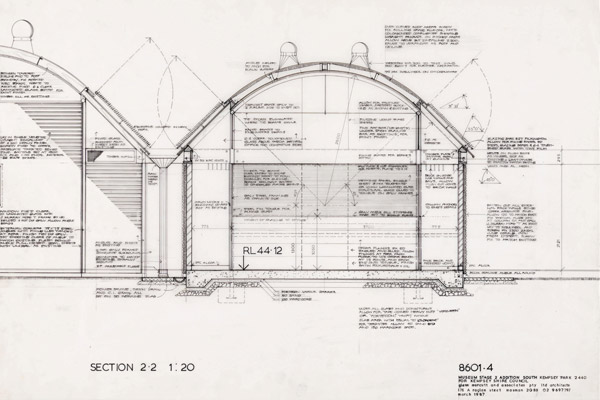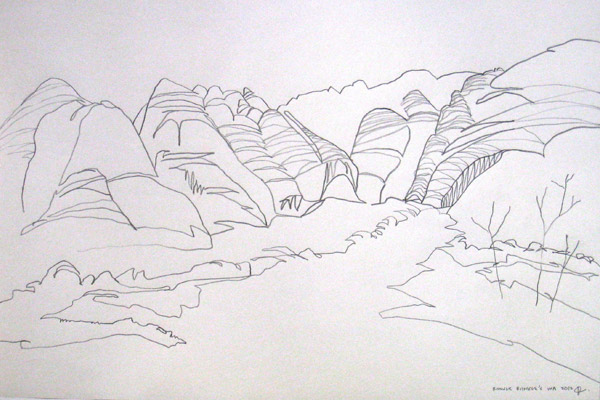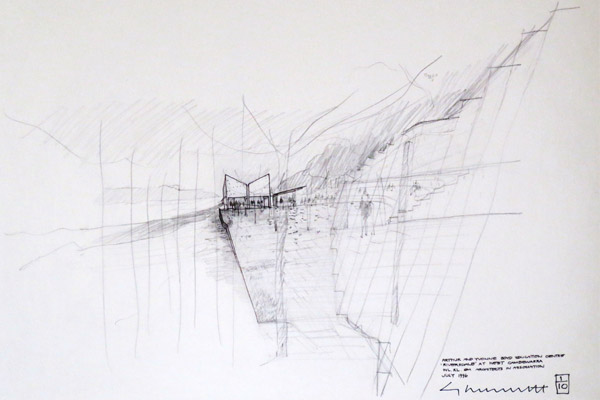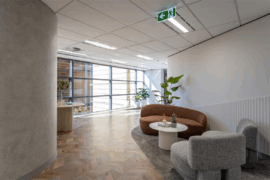Phillip Drew explores this year’s ‘Drawn by Design’, the bi-annual exhibition of drawings by prominent Australian architects.

April 2nd, 2014
Above: Glenn Murcutt – Kempsey Museum
An American GI, imprisoned during the Korean War, spent his captivity imagining the future house he would build on his return to California. Mentally constructing his dream house stick-by-stick occupied him and kept him sane during years of solitary confinement by the Chinese. On his repatriation he built his house exactly as he had designed it in his head. This is testimony to the value of mentally rehearsing an action. Cricketers, athletes and pianists, are taught to mentally rehearse a piece of music or physical action because this is almost as effective as doing it.
When we draw, we imaginatively enact the thing itself whether it is a landscape, an existing or imagined building. Drawing is a very special activity engaging the mind in the future. Making a document on a computer by keystrokes is not the same, the connection is much more indirect and remote from the object.
Renaissance artists often went on to apply their mastery of drawing to architecture. This institutionalised the connection between the artistic and architecture which survives to the present day. One need only recall Michelangelo to witness the connection between drawing, sculpture and architecture. The bi-annual exhibitions of drawings by prominent Australian architects at Art Atrium is an opportunity to celebrate this crucial link between drawing and architecture.

Peter Stutchbury – Bungles Bungles WA
Whether the subject is landscape, in Peter Stutchbury’s evocative rendition of the Bungle Bungles of Western Australia, landscape and architecture, in Peter Ray’s magnificent Then to the Golden Temple, or architecture alone, as in Ken Maher’s beautifully sensitive street scene, Siena 78, or Cortona, images such as these do more than illustrate a conscious awareness crucial to an imaginative construction of the future. They express an attitude and suggest important values that point out a deeper orientation. Much Australian architecture in the past has been about, and reflected, the transplantation of European civilisation in Australia. Little attention was paid to noticing place or making it the source of a new sensibility. That is why the act of drawing landscape is crucial, it demonstrates attention to the here and nowbeing present instead of absent from where we have chosen to live our lives.

Glenn Murcutt – Arthur Boyd Centre
Drawing must remain central to design, not be a post-design rationalisation completed afterwards as instanced in Philip Cox’s watercolour of the Australian National Maritime Museum, or Glenn Murcutt’s atmospheric Arthur and Yvonne Boyd Education Centre.
Murcutt was recently quoted as saying: ”Drawing is a critical aspect of thinking.” Banning computers from his classes, the prominence of the working drawing of Kempsey Museum reflects a trend initiated by English architect, James Stirling, in the 1950s. Stirling deliberately challenged the Renaissance artist/architect orthodoxy by introducing axonometric projections to coincide with a shift towards a more diagrammatic engineering style of graphic communication.
The most notorious instance of such confusion between post- and conceptual-representations are Jørn Utzon’s sketches of the Sydney Opera Houses roofs, done years later, but mistakenly viewed as prime evidence of his concept. Nothing could be more misleading!
Drawing may also be a means of reclaiming discoveries: Malcolm Carvers Carriage House, is superb. It has more impact than any photograph, yet makes details build to a comprehensive and moody recital of a bygone reality. Drawings also honour subjects we admire. Take Rena Czaplinska-Archers Sea Ranch, sketch. You feel the raking wind, the gaunt rugged coast, the fierce exposure of Moore, Turnbull, Whitacker’s 1965 condominium apartments.
Drawing gives the architect an active direct engagement with his/her surroundings. It re-calibrates the mind and assists it in assimilating experience. As such, it is essential to thinking and design, and ultimately, in communicating to others new concepts in a manner that the computer can never compete with. Drawing is personal by its very nature, it conveys as no computer can, the unique personal vision of the drawer and has no equivalent any more than an email is to a handwritten letter.
Drawn by Design is on at Art Atrium, 181 Old South Head Road, Bondi Junctio, from 25 March to 19 April.
artatrium.com.au/exhibitions.html
Philip Drew is a Sydney architectural historian and critic. He is currently writing FRAGMENTS –
the story of Sydney from its details.
INDESIGN is on instagram
Follow @indesignlive
A searchable and comprehensive guide for specifying leading products and their suppliers
Keep up to date with the latest and greatest from our industry BFF's!

For a closer look behind the creative process, watch this video interview with Sebastian Nash, where he explores the making of King Living’s textile range – from fibre choices to design intent.

For those who appreciate form as much as function, Gaggenau’s latest induction innovation delivers sculpted precision and effortless flexibility, disappearing seamlessly into the surface when not in use.

Merging two hotel identities in one landmark development, Hotel Indigo and Holiday Inn Little Collins capture the spirit of Melbourne through Buchan’s narrative-driven design – elevated by GROHE’s signature craftsmanship.

BOYAC celebrates traditional artisan skills while keeping an eye to the future with their collection of finely-crafted textiles and interior products from the most revered and sought-after fabric houses from around the world.

Fender Katsalidis and SOM’s triumphant design for Central Place, a $2.5 billion commercial development as part of Sydney Tech Central, has been unveiled.
The internet never sleeps! Here's the stuff you might have missed

Making a splash on the hair spa scene, the latest project from X + O makes a little slice of Japan right at home in suburban Melbourne.

Ra:tio café blends calm interiors and lush outdoor spaces through VAL Atelier and The Pinewood Studio’s refined, contemporary design.

Auckland Design Week returns for its third edition in March, unveiling an expanded programme and a renewed focus on the relationship between people, communities and the places they shape.

A thoughtful, low-waste redesign by PMG Group in collaboration with Goodman has transformed a dated office into a calm, contemporary workspace featuring a coastal-inspired palette and Milliken flooring for a refined finish.